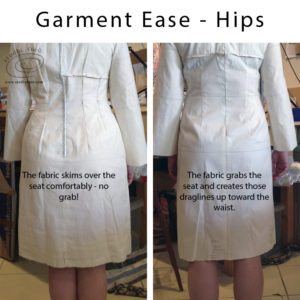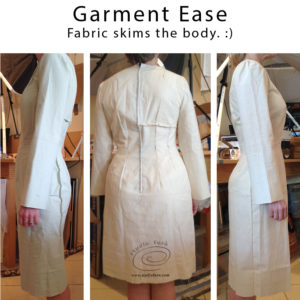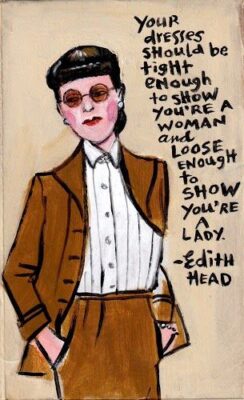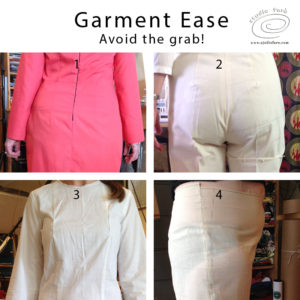28 Feb Understanding Garment Ease
Posted at 13:06h
in Fitting Patterns, Garment Blocks, Pattern Fitting Tutorials, Sewing Pattern Alterations
0 Comments
As a follow-on from Taking Body Measurements, this tutorial will help everyone understand garment ease, what it’s for and how to use it in pattern making. Garment ease is the minimum amount of fabric we add to our body measurements so that our woven garments are comfortable in wearing. That is, enough extra fabric to sit comfortably, bend your elbow, reach forward to grip the steering wheel when you drive your car or use the computer, sit down, eat lunch, bend your knees, etc. When fitting basics blocks for woven fabrics, you’ll always include the full ease allowance and when you cut patterns from these blocks you can alter the ease to suit the design and fabric you’re cutting.

What you’re looking for in the fit of your block is for the fabric to skim the body but not grab. The drag lines you see in the second photo indicate tension between the hip and waist. To get rid of the drag lines you’ll need to add a little extra fabric around the hip area. In this case I’d suggest adding a total of 2cm to the hip on the back dress.
The examples above are fittings that demonstrate the need for ease to be added in specific areas:
- In the back of this dress you can see the toile grabbing on the high hip. Consider adding some extra on the side seam from the waist through to the high hip, gently meeting the curve on the hip level.
- In the trouser fitting it looks as if there is no ease at all in the back of the trouser. To fix this I’d add 1cm on the back hip (total 2cm in back trouser). And I’d also add 2-3cm to the back inside leg to increase fabric in the thigh area.
- The dress toile is grabbing around the bust area. In this case I’d add an extra centimetre to each side of the dress in the underarm area. This will have an impact on the fit of the sleeve. You may need to add the same amount the the front sleeve at the underarm seam.
- This trouser toile is too tight all round. I’d suggest cutting again in a larger size then altering to fit the individual body.

For example, when I cut trousers I use my block with the full 4cm garment eased on the hip. Then I reduce that ease to cut myself a fashion fit trouser most likely using a woven fabric with a little technical stretch. If I’m cutting stretch woven fabric into trousers for a slim pant, I’ll reduce the fit of the block to body measurement only. However in the end fittings are at the discretion of the maker and the wearer. How you use your garment ease is finally down to you. I do like what Edith Head has to say about fitting garments.

If you fancy trying out some of my garment blocks for your own pattern making projects, have a look at this Size Chart and select the size closest to your measurements. Let me know if you have any questions about this post or my garment blocks.



No Comments